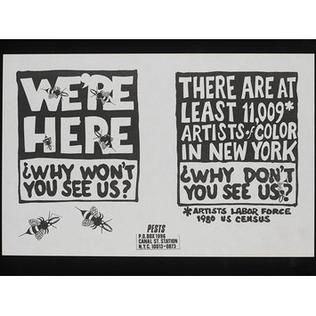Guerrilla Girls is an anonymous group of feminist, female artists devoted to fighting sexism and racism within the art world. The group formed in New York City in 1985 with the mission of bringing gender and racial inequality into focus within the greater arts community. The group employs culture jamming in the form of posters, books, billboards, and public appearances to expose discrimination and corruption. They also often use humor in their work to make their serious messages engaging. They are known for their "guerilla" tactics, hence their name, such as hanging up posters or staging surprise exhibitions. To remain anonymous, members don gorilla masks and use pseudonyms that refer to deceased female artists such as Frida Kahlo, Kathe Kollwitz, and Alice Neel. According to GG1, identities are concealed because issues matter more than individual identities, "Mainly, we wanted the focus to be on the issues, not on our personalities or our own work."
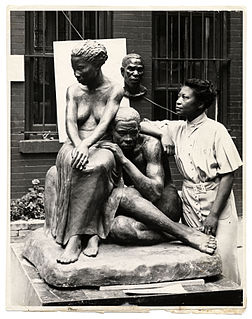
African-American art is a broad term describing visual art created by Americans who also identify as Black. The range of art they have created, and are continuing to create, over more than two centuries is as varied as the artists themselves. Some have drawn on cultural traditions in Africa, and other parts of the world, for inspiration. Others have found inspiration in traditional African-American plastic art forms, including basket weaving, pottery, quilting, woodcarving and painting, all of which are sometimes classified as "handicrafts" or "Folk Art."

The Whitney Biennial is a biennial exhibition of contemporary American art, typically by young and lesser known artists, on display at the Whitney Museum of American Art in New York City, United States. The event began as an annual exhibition in 1932; the first biennial was in 1973. The Whitney show is generally regarded as one of the leading shows in the art world, often setting or leading trends in contemporary art. It helped bring artists like Georgia O'Keeffe, Jackson Pollock, and Jeff Koons to prominence.
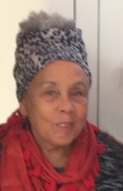
Betye Irene Saar is an African-American artist known for her work in the medium of assemblage. Saar is a visual storyteller and an accomplished printmaker. Saar was a part of the Black Arts Movement in the 1970s, which engaged myths and stereotypes about race and femininity. Her work is considered highly political, as she challenged negative ideas about African Americans throughout her career; Saar is best known for her art work that critiques American racism toward Blacks.

A.I.R. Gallery is the first all female artists cooperative gallery in the United States. It was founded in 1972 with the objective of providing a professional and permanent exhibition space for women artists during a time in which the works shown at commercial galleries in New York City were almost exclusively by male artists. A.I.R. is a not-for-profit, self-underwritten arts organization, with a board of directors made up of its New York based artists. The gallery was originally located in SoHo at 97 Wooster Street, and was located on 111 Front Street in the DUMBO neighborhood of Brooklyn until 2015. In May 2015, A.I.R. Gallery moved to its current location at 155 Plymouth St, Brooklyn, NY 11201.
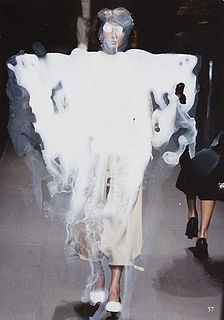
Feminist art is a category of art associated with the late 1960s and 1970s feminist movement. Feminist art highlights the societal and political differences women experience within their lives. The hopeful gain from this form of art is to bring a positive and understanding change to the world, in hope to lead to equality or liberation. Media used range from traditional art forms such as painting to more unorthodox methods such as performance art, conceptual art, body art, craftivism, video, film, and fiber art. Feminist art has served as an innovative driving force towards expanding the definition of art through the incorporation of new media and a new perspective.
The Art Workers' Coalition (AWC) was an open coalition of artists, filmmakers, writers, critics, and museum staff that formed in New York City in January 1969. Its principal aim was to pressure the city's museums – notably the Museum of Modern Art – into implementing economic and political reforms. These included a more open and less exclusive exhibition policy concerning the artists they exhibited and promoted: the absence of women artists and artists of color was a principal issue of contention, which led to the formation of Women Artists in Revolution (WAR) in 1969. The coalition successfully pressured the MoMA and other museums into implementing a free admission day that still exists in certain museums to this day. It also pressured and picketed museums into taking a moral stance on the Vietnam War which resulted in its famous My Lai poster And babies, one of the most important works of political art of the early 1970s. The poster was displayed during demonstrations in front of Pablo Picasso′s Guernica at the MoMA in 1970.

Linda Goode Bryant is an African American documentary filmmaker and activist. She founded the gallery Just Above Midtown (JAM), which will be the focus of an exhibition at the Museum of Modern Art in the fall of 2022 organized by curator Thomas Lax.
Jeff Donaldson was a visual artist whose work helped define the Black Arts Movement of the 1960s and 1970s. Donaldson, co-founder of AfriCOBRA and contributor to the momentous Wall of Respect, was a pioneer in African-American personal and academic achievement. His art work is known for creating alternative black iconography connected to Africa and rooted in struggle, in order to replace the history of demeaning stereotypes found in mainstream white culture.

Howardena Pindell is an American artist, curator, and educator. She is known as a painter and mixed media artist, her work explores texture, color, structures, and the process of making art; it is often political, addressing the intersecting issues of racism, feminism, violence, slavery, and exploitation. She is known for the wide variety of techniques and materials used in her artwork; she has created abstract paintings, collages, "video drawings," and "process art."
Naomi Beckwith is a senior curator at the Museum of Contemporary Art, Chicago. Beckwith joined the curatorial staff in May 2011.
"Where We At" Black Women Artists, Inc. (WWA) was a collective of Black women artists affiliated with the Black Arts Movement of the 1960s and 1970s. It included artists such as Dindga McCannon, Kay Brown, Faith Ringgold, Carol Blank, Jerri Crooks, Charlotte Kâ (Richardson), and Gylbert Coker. Where We At was formed in the spring of 1971, in the wake of an exhibition of the same name organized by 14 Black women artists at the Acts of Art Gallery in Greenwich Village. Themes such as the unity of the Black family, Black female independence and embodiment, Black male-female relationships, contemporary social conditions, and African traditions were central to the work of the WWA artists. The group was intended to serve as a source of empowerment for African-American women, providing a means for them to control their self-representation and to explore issues of Black women's sensibility and aesthetics. Like AfriCobra, a Chicago-based Black Arts group, the WWA was active in fostering art within the African-American community and using it as a tool of awareness and liberation. The group organized workshops in schools, jails and prisons, hospitals, and cultural centers, as well as art classes for youth in their communities.
Feminist art criticism emerged in the 1970s from the wider feminist movement as the critical examination of both visual representations of women in art and art produced by women. It continues to be a major field of art criticism.
Dyke Action Machine! or DAM! is a public art and activist duo made up of designer Carrie Moyer and photographer Sue Schaffner. DAM! gained notoriety in the 1990s for using commercial photography styling with lesbian imagery in public art.

Janet Henry is a visual artist based in New York City.
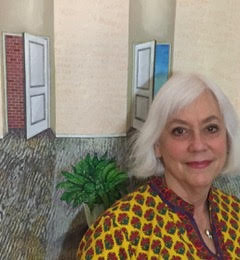
Robin Tewes is a Queens-born, New York City-based artist, known since the early 1980s for her representational paintings of frozen, narrative-like moments. She has shown her work in numerous solo exhibitions in New York City, as well as nationally and internationally, and exhibited at venues including P.S. 1, the Museum of Modern Art, the Whitney Museum, The Drawing Center, and the Central Academy of Fine Arts (Beijing), among many. Her work has been widely discussed in publications including Artforum, Art in America, ARTnews, Tema Celeste, the New York Times, the Los Angeles Times, and the Village Voice. Tewes was a founding member of the P.S. 122 Painting Association. She has been recognized with a Pollock-Krasner Foundation Fellowship (2015) and Painting Award (2008), an Adolph and Esther Gottlieb Foundation Award (2007), and inclusion in the Smithsonian Archives of American Art in 2016.
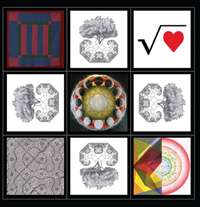
Rhythm of Structure is a multimedia interdisciplinary project founded in 2003. It features a series of exhibitions, performances, and academic projects that explore the interconnecting structures and process of mathematics and art, and language, as way to advance a movement of mathematical expression across the arts, across creative collaborative communities celebrating the rhythm and patterns of both ideas of the mind and the physical reality of nature.

We Wanted a Revolution: Black Radical Women, 1965–85 is an exhibition held in the Brooklyn Museum of Art from April 21, 2017 through September 17, 2017. Exhibition surveys the last twenty years of black female art and presents more than forty artists and activists who decided to dedicate their work to the fight against racism, sexism, homophobia, and class injustice. It is not organized chronologically or by authorship, but thematically.
Ayana M. Evans, is an African-American performance artist and educator based in New York City and an adjunct professor of visual art at Brown University. She also serves as editor-at-large of Cultbytes, an online art publication.
Sewell Sillman was an American painter, educator, and print publisher. He co-founded Ives-Sillman, Inc. alongside partner Norman Seaton Ives, which published silkscreen prints and photographs in monographic art portfolios.
